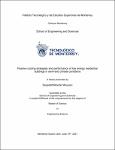| dc.contributor.advisor | Rivera Solorio, Carlos Iván | |
| dc.contributor.author | Mousavi, SeyedehNiloufar | |
| dc.creator | RIVERA SOLORIO, CARLOS IVAN; 121148 | |
| dc.date.accessioned | 2022-09-27T00:44:04Z | |
| dc.date.available | 2022-09-27T00:44:04Z | |
| dc.date.created | 2019-08-19 | |
| dc.date.issued | 2021-06-15 | |
| dc.identifier.citation | Mousavi, S. (2021). Passive cooling strategies and performance of low energy residential buildings in semi-arid climate conditions (Tesis de maestría). Instituto Tecnológico y de Estudios Superiores de Monterrey. Recuperado de: https://hdl.handle.net/11285/649739 | es_MX |
| dc.identifier.uri | https://hdl.handle.net/11285/649739 | |
| dc.description.abstract | This numerical study compares annual energy consumption of three building prototypes under semi-arid climate conditions of Monterrey. These common cases were selected based on Mexican housing classification of houses including, one story house, apartment of 4 story house, double story house, named C1, C2, and C3, which were simulated using DesignBuilder software. Based on literature reviews and availability of materials, 6 scenarios were defined for walls component, similarly 6 scenarios for the roof of all cases with the application of phase change material (PCM), reflective paint, and insulation. Regarding the opening envelope of cases 5 scenarios were defined including the application of double clear glazing, double low-e glazing, and reflective glazing coupled with shading. Selection factor to find the most efficient combination were based on annual energy and material cost of scenarios against each other and base case. Firstly, for wall component of envelope results showed that PCM with insulation (PI) outperformed other scenarios for all cases however with regards to its cost reflective paint with insulation (Ir) was more efficient, similar pattern was found for roof component for all cases where Ir scenario outperformed in term of cost and energy. Secondly, with regards to the opening scenarios loE double glazing coupled with horizontal shading outperformed others, consequently three selected scenarios were combined for all cases and formed the energy efficient configuration (EEC) to analyze the improvement in indoor thermal comfort, thermal improvement, carbon emission reduction, and economic benefit of their application. Various actions are carried out to perform these analyses; calibration of the model with experimental data and comparative ASHRAE benchmark case study 600FF, climate data simulations with TRNSYS software, and sensitivity analysis for PCM selection. Also, it was found that PCM was effective strategy if the thickness of material increases to similar thickness as insulation it could save up to 57% of energy for C1 which is the highest saving rate as compared to all other scenarios, however due to its high cost it is not economically efficient in local context.
The results demonstrate that EEC cases achieved total annual energy saving of around 53%, 55%, and 58% for C1, C2, and C3 cases, furthermore, concerning the thermal comfort improvement were around 45%, 33%, and 38% respectively. With regards to thermal performance during hottest day temperature, improvement was observed with averages of 5.9°C and 3.2°C for C1 and C3 whereas C2 had no improvement during this period, however during coldest day all cases had an average improvement of 2.4°C, 2°C, and 2.6°C. Concerning the Carbon footprints, reduction of emission for each case of C1, C2 and C3 were around 1578 Kg, 2798 Kg, and 3004 Kg annually, with 6 years, period of return for C1 and almost 3.5 years for C2 and C3. To conclude, the scenarios studied could be integrated with renewable sources of energy supply such as PV panels and result in net-zero building envelope, as all cases almost saved more than 50% of energy. | es_MX |
| dc.format.medium | Texto | es_MX |
| dc.language.iso | eng | es_MX |
| dc.publisher | Instituto Tecnológico y de Estudios Superiores de Monterrey | es_MX |
| dc.relation.isFormatOf | versión publicada | es_MX |
| dc.relation.isreferencedby | REPOSITORIO NACIONAL CONACYT | |
| dc.rights | openAccess | es_MX |
| dc.rights.uri | http://creativecommons.org/licenses/by-nc-nd/4.0 | es_MX |
| dc.subject.classification | INGENIERÍA Y TECNOLOGÍA::CIENCIAS TECNOLÓGICAS::TECNOLOGÍA DE LA CONSTRUCCIÓN::TRANSMISIÓN DE CALOR EN LA EDIFICACIÓN | es_MX |
| dc.subject.lcsh | Technology | es_MX |
| dc.title | Passive cooling strategies and performance of low energy residential buildings in semi-arid climate conditions | es_MX |
| dc.type | Tesis de Maestría / master Thesis | es_MX |
| dc.contributor.department | School of Engineering and Sciences | es_MX |
| dc.contributor.committeemember | Lopez Salinas, Jose Luis | |
| dc.contributor.mentor | Gijón Rivera, Miguel Ángel | |
| dc.identifier.orcid | https://orcid.org/0000-0002-6886-2286 | es_MX |
| dc.subject.keyword | Passive cooling | es_MX |
| dc.subject.keyword | Building energy efficiency | es_MX |
| dc.subject.keyword | Building simulation | es_MX |
| dc.subject.keyword | Phase change material | es_MX |
| dc.contributor.institution | Campus Monterrey | es_MX |
| dc.contributor.cataloger | hermlugo, emipsanchez | es_MX |
| dc.description.degree | Master of Science in Engineering Science | es_MX |
| dc.identifier.cvu | 1019581 | es_MX |
| dc.date.accepted | 2021-06-15 | |
| dc.audience.educationlevel | Investigadores/Researchers | es_MX |
| dc.identificator | 7||33||3305||330590 | es_MX |


